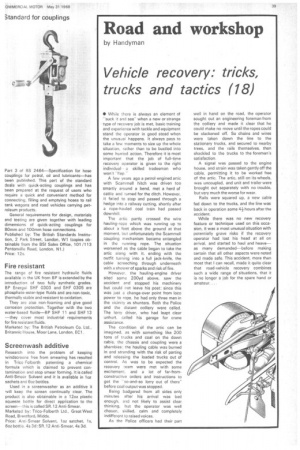Road and workshop
Page 41

If you've noticed an error in this article please click here to report it so we can fix it.
by Handyman
Vehicle recovery: tricks, trucks and tactics (18)
• While there is always an element of -suck it and see" when a new or strange type of recovery job is met, basic training and experience with tackle and equipment stand the operator in good stead when the unusual happensIt always pays to take a few moments to size up the whole situation, rather than to be bustled into some hurried action. Therefore it is most important that the job of full-time recovery operator is given to the right individual-' a skilled tradesman who won't "flap."
A few years ago a petrol-engined artic with Scammell hitch was driven too smartly around a bend, met a herd of cattle and turned for the ditch. However. it failed to stop and passed through a hedge into a railway cutting, shortly after a rope-hauled coal train had passed downhill.
The artic partly crossed the wire hauling-rope which was running up to about a foot above the ground at that moment, but unfortunately the Scammell coupling mechanism became entangled in the running rope. The situation worsened as the cable began to take the artic along with it, ending with the outfit turning into a full jack-knife, the cable screeching through underneath with a shower of sparks and risk of fire.
However, the hauling-engine driver sited some 200yd above, saw the accident and stopped his machinery but could not leave his post; since this was just a change-over point from loco power to rope, he had only three men in the vicinity as shunters. Both the Police and the distant colliery were called. The lorry driver, who had leapt clear unhurt, called his garage for crane assistance.
The condition of the artic can be imagined, as with something like 200 tons of trucks and coal on the down cable, the chassis and coupling were a shambles: the hauling cable was burned in and stranding with the risk of parting and releasing the loaded trucks out of control. As was to be expected the recovery team were met with some excitement, and a lot of far-fromconstructive orders and instructions to get the "so-and-so lorry out of there" before coal output was stopped.
Being badgered from all sides only minutes after his arrival was bad enough, and not likely to assist clear thinking, but the operator was well chosen, skilled, calm and completely indifferent to raised voices.
As the Police officers had their part well in hand on the road, the operator sought out an engineering foreman from the colliery and made it clear that he could Make no move until the ropes could be slackened off. So chains and wires were taken down the line to the stationary trucks, and secured to nearby trees, and the rails themselves, then shackled to the trucks to the foreman's satisfaction.
A signal was passed to the engine house, and strain was taken gently off the cable, permitting it to be worked free of the artic. The artic, still on its wheels, was uncoupled, and unit and trailer were brought out separately with no trouble, but very much the worse for wear.
Rails were squared up, a new cable fed down to the trucks, and the line was back in operation some 4+ hours after the accident.
While there was no new recovery feature or technique used on this occasion, it was a most unusual situation with potentially grave risks if the recovery operator had lost his head at all on arrival, and started to haul and heave— as many demanded—before making certain that all other aspects were noted and made safe. This accident, more than most that I can recall, made it quite clear that road-vehicle recovery combines such a wide range of situations, that it is no longer a job for the spare hand or amateur. • ..








































































































